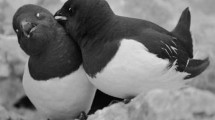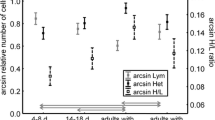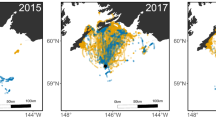Abstract
Breeding has a high energetic cost and, in central place foragers, also restricts the ability of parents for self-foraging, with affecting on their body and immunological conditions. In migratory species, breeding overlaps the period of recovery of body conditions before the following outbound migration. Those factors may reduce the breeding success and even lead parents to abandon their offspring if parental body condition cannot guarantee the success of the next migration. We studied the body and immunological conditions of a low breeding success population of Brown Skuas (Stercorarius antarcticus lonnbergi) throughout their breeding season. We evaluated changes in their body mass, blood parameters and heterophil:lymphocyte ratios (H:L), at three stages of their breeding period: Incubation, Early rearing and Late rearing. The body mass of female Brown skuas decreased during the initial stages of the breeding period and recovered towards the end. The changes in metabolites suggest a use of protein body reserves but not of lipid reserves. The H:L ratio did not indicate changes in the immune condition of the birds. Our results suggest that this low breeding success population begins its breeding period with a poor body condition that it continues to decline throughout the season. Those poor body conditions added to the need for recovery for the next migration may be the cause of the abandonment of almost totally feathered chicks. Our evidence highlights the importance of food availability, in either the breeding or wintering sites, or both, on the health of the populations of migratory top predators.





Similar content being viewed by others
References
Alonso-Alvarez C, Ferrer M, Velando A (2002) The plasmatic index of body condition in Yellow-legged Gulls Larus cachinnans: a food-controlled experiment. Ibis 144:147–149
Antonio-Garcia MT, Hermosa Y, Aguirre JI (2010) Does breeding status influence haematology and blood biochemistry of yellow-legged gulls? Acta Biol Hung 61:391–400
Boersma D, Ryder JP (1983) Reproductive performance and body condition of earlier and later nesting Ring-billed Gulls. J Field Ornithol 54:374–380
Campbell T (1994) Hematology. Avian medicine: principles and application. Wingers, Lake Worth, pp 176–198
Carneiro APB, Manica A, Trivelpiece WZ, Phillips RA (2015) Flexibility in foraging strategies of Brown Skuas in response to local and seasonal dietary constraints. J Ornithol 156:625–633
Carrascal LM, Senar JC, Mozetich I, Uribe F, Domenech J (1998) Interactions among environmental stress, body condition, nutritional status, and dominance in great tits. Auk 115:727–738
Chaurand T, Weimerskirch H (1994) Incubation routine, body mass regulation and egg neglect in the Blue Petrel Halobaena caerulea. Ibis 136:285–290
Cherel Y, Le Maho Y (1985) Five months of fasting in king penguin chicks: body mass loss and fuel metabolism. Am J Physiol 18:R387–R392
Cherel Y, Robin J-P, Maho YL (1988) Physiology and biochemistry of long-term fasting in birds. Can J Zool 66:159–166
Cirule D, Krama T, Vrublevska J, Rantala MJ, Krams I (2012) A rapid effect of handling on counts of white blood cells in a wintering passerine bird: a more practical measure of stress? J Ornithol 153:161–166
Croll DA, Gaston AJ, Noble DG (1991) Adaptive loss of mass in thick-billed murres. Condor 93:496–502
D’Amico VL, Bertellotti M, Baker AJ, González PM (2010) Hematologic and plasma biochemistry values for endangered red knots (Calidris canutus rufa) at wintering and migratory sites in Argentina. J Wildl Dis 46:644–648
Davies AK, Maney DL, Maerz DL (2008) The use of leukocyte profiles to measure stress in vertebrates: a review for ecologists. Func Ecol 22:760–772
Drent RH, Daan S (1980) The prudent parent: energetic adjustments in Avian breeding. Ardea 68:225–252
Ellis HI, Jehl JR Jr (1991) Total body water and body composition in phalaropes and other birds. Physiol Zool 64:973–984
Ferrer M, Belliure J, Vinuela J, Martin B (2013) Parental physiological condition and reproductive success in chinstrap penguins (Pygoscelis antarctica). Polar Biol 36:529–535
Gauthier-Clerc M, Le Maho Y, Gender J-P, Durant J, Handrich Y (2001) State-dependent decisions in long-term fasting king penguins, Aptenodytes patagonicus, during courtship and incubation. Anim Behav 62:661–669
Graña Grilli M (2014) Decline in numbers of Antarctic skuas breeding at Potter Peninsula, King George Island, Antarctica. Mar Ornithol 42:161–162
Griffiths R, Double MC, Orr K, Dawson RJ (1998) A DNA test to sex most birds. Mol Ecol 7:1071–1075
Groscolas R, Lacroix A, Robin J-P (2008) Spontaneous egg or chick abandonment in energy-depleted king penguins: a role for corticosterone and prolactin? Horm Behav 53:51–60
Guglielmo CG, Cerasale DJ, Eldermire C (2005) A field validation of plasma metabolite profiling to assess refueling performance of migratory birds. Physiol Biochem Zool 78:116–125
Gustafsson L, Nordling D, Andersson MS, Sheldon BC, Qvarnstrom A (1994) Infectious diseases, reproductive effort and the cost of reproduction in birds. Philos Trans R Soc Lond B Biol Sci 346:323–331
Hagelin JC, Miller GD (1997) Nest-site selection in south polar skuas: balancing nest safety and access to resources. Auk 114:638–645
Hahn S, Reinhardt K, Ritz MS, Janicke T, Montalti D, Peter H-U (2007) Oceanographic and climatic factors differentially affect reproduction performance of Antarctic skuas. Mar Ecol Prog Ser 334:287–297
Harding AM, Welcker J, Steen H, Hamer KC, Kitaysky AS, Fort J, Talbot SL, Cornick LA, Karnovsky NJ, Gabrielsen GW et al (2011) Adverse foraging conditions may impact body mass and survival of a high Arctic seabird. Oecologia 167:49–59
Harvey S, Phillips JG, Rees A, Hall TR (1984) Stress and adrenal function. J Exp Zool 232:633–645
Hayashi K, Nagai Y, Ohtsuka A, Tomita Y (1994) Effects of dietary corticosterone and trilostane on growth and skeletal muscle protein turnover in broiler cockerels. Br Poult Sci 35:789–798
Hennicke JC, James DJ, Weimerskirch H (2015) Sex-Specific habitat utilization and differential breeding investments in Christmas Island Frigatebirds throughout the breeding cycle. PLoS One 10:e0129437
Holmes WN, Wrights A, Gorsline J (1983) Effects of aldosterone and corticosterone on cloacal water and electrolyte excretion of constantly-loaded intact and colostomized ducks (Anas platyrynchos). Comp Biochem Physiol 74:795–805
Ibañez A, Graña Grilli M, Figueroa A, Pari M, Montalti D (2018) Declining health status of Brown Skua (Stercorarius antarcticus lonnbergi) parents and their offspring during chick development. Polar Biol 41:193–200
Kalmbach E, Griffiths R, Crane JE, Furness RW (2004) Effects of experimentally increased egg production on female body condition and laying dates in the great skua Stercorarius skua. J Avian Biol 35:501–514
Klaassen M, Abraham KF, Jefferies RL, Vrtiska M (2006) Factors affecting the site of investment, and the reliance on savings for arctic breeders: the capital–income dichotomy revisited. Ardea 94:371–384
Krietsch J, Esefeld J, Braun C, Lisovski S, Peter H-U (2016) Long-term dataset reveals declines in breeding success and high fluctuations in the number of breeding pairs in two skua species breeding on King George Island. Polar Biol 39:573–582
Krietsch J, Hahn S, Kopp M, Phillips RA, Peter H-U, Lisovski S (2017) Consistent variation in individual migration strategies of brown skuas. Mar Ecol Prog Ser 578:213–225
Kulaszewicz I, Wojczulanis-Jakubas K, Jakubas D (2017) Trade-offs between reproduction and self-maintenance (immune function and body mass) in a small seabird, the little auk. J Avian Biol 48:371–379
Lebigre C, Alatalo RV, Kilpimaa J, Staszewski V, Siitari H (2012) Leucocyte counts variation and measures of male fitness in the lekking Black Grouse. J Ornithol 153:95–102
Lumeij JT (1987) The diagnostic value of plasma proteins and nonprotein nitrogen substances in birds. Vet Q 9:262–268
Lyons JE, Collazo JA, Guglielmo CG (2008) Plasma metabolites and migration physiology of semipalmated sandpipers: refueling performance at five latitudes. Oecologia 155:417–427
Machado-Filho RA, Balsamão GM, Marini MÂ (2010) Seasonal differences in immune profiles and body conditions of migratory and permanent resident neotropical flycatchers. Condor 112:579–590
Marra PP, Holberton RL (1998) Corticosterone levels as indicators of habitat quality: effects of habitat segregation in a migratory bird during the non-breeding season. Oecologia 116:284–292
Masello JF, Quillfeldt P (2004) Are haematological parameters related to body condition, ornamentation and breeding success in wild burrowing parrots Cyanoliseus patagonus? J Avian Biol 35:445–454
McWilliams SR, Guglielmo C, Pierce B, Klaassen M (2004) Flying, fasting, and feeding in birds during migration: a nutritional and physiological ecology perspective. J Avian Biol 35:377–393
Minias P (2014) High glucose concentrations are associated with symptoms of mild anaemia in Whiskered Terns: consequences for assessing physiological quality in birds. J Ornithol 155:1067–1070
Mitchell GW, Wheelwright NT, Guglielmo CG, Norrys DR (2012) Short-and long-term costs of reproduction in a migratory songbird. Ibis 154:325–337
Moreno-Rueda G (2011) Trade-off between immune response and body mass in wintering house sparrows (Passer domesticus). Ecol Res 26:943–947
Murphy ME (1996) Nutrition and metabolism. Avian energetics and nutritional ecology. Chapman & Hall, New York, pp 31–60
Nathan R, Getz WM, Revilla E, Holyoak M, Kadmon R, Saltz D, Smouse PE (2008) A movement ecology paradigm for unifying organismal movement research. Proc Natl Acad Sci 105:19052–19059
Norris K, Evans MR (2000) Ecological immunology: life history trade-offs and immune defense in birds. Behav Ecol 11:19–26
Ouyang JQ, Sharp PJ, Dawson A, Quetting M, Hau M (2011) Hormone levels predict individual differences in reproductive success in a passerine bird. Proc R Soc Lond B Biol Sci 278:2537–2545
Pezzo F, Olmastroni S, Corsolini S, Forcadi S (2001) Factors affecting the breeding success of south polar skuas Catharacta maccormicki at Edmonson Point, Victoria Land, Antarctica. Polar Biol 24:389–393
Phillips RA, Dawson DA, Ross DJ (2002) Mating patterns and reversed size dimorphism in Southern Skuas (Stercorarius skua lonnbergi). Auk 119:858–863
Price ER (2010) Dietary lipid composition and avian migratory flight performance: development of a theoretical framework for avian fat storage. Comp Biochem Physiol A Mol Integr Physiol 157:297–309
R Core Team (2014) R: A language and environment for statistical computing. Austria, Vienna
Rae LF, Mitchell GW, Mauck RA, Guglielmo CG, Norris DR (2009) Radio transmitters do not affect the body condition of Savannah Sparrows during the fall premigratory period. J Field Ornithol 80:419–426
Ritz MS, Hahn S, Janicke T, Peter H-U (2006) Hybridisation between South polar skua (Catharacta maccormicki) and Brown skua (C. antarctica lonnbergi) in the Antarctic Peninsula region. Polar Biol 29:253–259
Seewagen CL, Sheppard CD, Slayton EJ, Guglielmo CG (2011) Plasma metabolites and mass changes of migratory landbirds indicate adequate stopover refueling in a heavily urbanized landscape. Condor 113:284–297
Selman RG, Houston DC (1996) The effect of prebreeding diet on reproductive output in zebra finches. Proc R Soc Lond B Biol Sci 263:1585–1588
Smith SB, McWilliams SR, Guglielmo CG (2007) Effect of diet composition on plasma metabolite profiles in a migratory songbird. Condor 109:48–58
Stephens PA, Boyd IL, McNamara JM, Houston AI (2009) Capital breeding and income breeding: their meaning, measurement, and worth. Ecology 90:2057–2067
Tveraa T, Saether B-E, Aanes R, Erikstad KE (1998) Body mass and parental decisions in the Antarctic petrel Thalassoica antarctica: how long should the parents guard the chick? Behav Ecol Sociobiol 43:73–79
Weimerskirch H (1990) Weight loss of Antarctic Fulmars Fulmarus glacialoides during incubation and chick brooding. Ibis 132:68–77
Weimerskirch H, Lys P (2000) Seasonal changes in the provisioning behaviour and mass of male and female wandering albatrosses in relation to the growth of their chick. Polar Biol 23:733–744
Weimerskirch H, Prince PA, Zimmermann L (2000) Chick provisioning by the Yellow-nosed Albatross Diomedea chlororhynchos: response of foraging effort to experimentally increased costs and demands. Ibis 142:103–110
Weimerskirch H, Le Corre M, Gadenne H, Pinaud D, Kato A, Ropert-Coudert Y, Bost C-A (2009) Relationship between reversed sexual dimorphism, breeding investment and foraging ecology in a pelagic seabird, the masked booby. Oecologia 161:637–649
Williams GC (1966) Natural selection, the costs of reproduction, and a refinement of Lack’s principle. Am Nat 100:687–690
Acknowledgements
This work was made possible thanks to the logistic and financial support of Instituto Antártico Argentino. We thank D. Podestá, F. Di Sallo, L. Pagano and E. Depino for their help in the fieldwork and J. Origlia for his training in leucocyte identification. We thank P. Plaza and two reviewers for their comments and K. Bildstein for improving the English.
Author information
Authors and Affiliations
Corresponding author
Ethics declarations
Conflict of interest
The authors declare that they have no conflict of interest.
Human and animal rights
The permit to carry out the fieldwork for this work was given by Dirección Nacional del Antártico. All applicable international, national, and institutional guidelines for sampling, care and experimental use of animals for the study were followed.
Additional information
Responsible Editor: Y. Cherel.
Reviewed by J-P. Robin and an undisclosed expert.
Rights and permissions
About this article
Cite this article
Graña Grilli, M., Pari, M. & Ibañez, A. Poor body conditions during the breeding period in a seabird population with low breeding success. Mar Biol 165, 142 (2018). https://doi.org/10.1007/s00227-018-3401-4
Received:
Accepted:
Published:
DOI: https://doi.org/10.1007/s00227-018-3401-4




